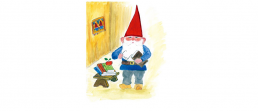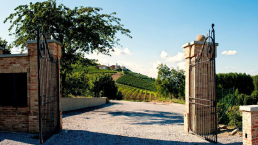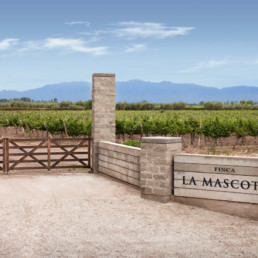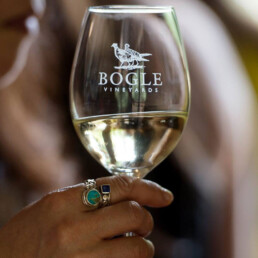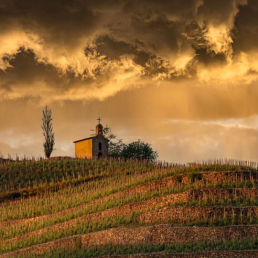D&N Wondermaker
Josetta Saffirio
The Wine of Kings (and the Tale of the Gnomes)
All great wines have a great story. And just occasionally they also have a great label. Quaint water-coloured gnomes in pointy red hats would certainly be distinct and eye catching. Gnomes, really? If at first you think it’s all a bit bonkers, actually, its not. These romantic creatures in Piemonte Italy are in no way related to their more kitsch cousins found around the garden ponds of England.
And this wild idea was not some 21st century marketing campaign brainstormed in chic admen offices but rather the endearing tale passed on through generations of a passionately quirky Italian winemaking family. These immediately recognisable gnomes grace the wine labels of today’s legendary Dhall & Nash Wondermaker Josetta Saffirio. We are most fortunate to have a Barolo producer that defies all the usual cliches.
“The gnomes represent the conscience of good men”
– JS website
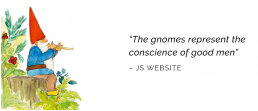
It is said that many great wines are made simply, and at Josetta Saffirio we have a producer with the nerve, intuition, and individuality to push for more simplicity, elegance, clarity, and still imbue depth of character. Fifth generation winemaker, Sara Vezza is crafting fine Barolo, Nebbiolo and Barbera with complete dedication to her craft and also pieno d’ amore for the family land.
Fun Fact: Barolo is known as The King of Wines and The Wine of Kings
Barolo still stands as one of the greatest Italian red wines to ever be produced. But perhaps the most impressive distinction that Barolo holds over most other Italian red wines is how it has impressed royalty over the years. Barolo was an enormous favourite of King Albert of Savoy, who is reputed to have purchased the Verduno Castle solely because it housed General Staglieno, who had a reputation for creating some of the best Barolos of the era. It takes a special kind of wine to be so good that it influences the decisions of royalty, and this interest in Barolo as the wine of kings extended into the 1800s when King Vittorio Emanuele II also took interest in the wine through the purchase of the legendary Fontanafredda estate. Befittingly Barolo has practically carried a royal seal of approval over many centuries.
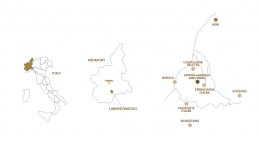
Casa Dolce Casa – Piemonte
Let’s explore the home of Josetta Saffirio wines
In the North-western region of Italy, bordering France and Switzerland, just west of Milan and south of Turin, sits Piemonte. It is well known for the high quality of its wines producing more DOCG designated wine (Italy’s top wine classification) than any other region in the country. The most famous wine producing areas are in the southern portion of the region in the hills known as the “Langhe”. This is the Nebbiolo grape growing heartland around a cluster of fog-prone hills close to the village of Barolo. Nebbiolo is the King grape here producing world famous Barolo and Barbaresco.
“Nebbiolo is the Italian grape that really sets wine lovers’ hearts racing.”
Jancis Robinson MW
Fun Fact: Nebbiolo is popularly thought to take its name from nebbia, Italian for fog that characteristically drapes the region’s hills in autumn.
The Barolo DOCG encompasses 11 different communes and more than 1200 growers in the region. The “Big Five” — Monforte d’Alba (Josetta Saffirio’s commune), La Morra, Castiglione Faletto, Serralunga d’Alba, and of course, Barolo — have the advantage of altitude and soil, producing nearly 90 percent of all Barolo, while the remaining six — Diano d’Alba, Grinzane Cavour, Novello, Cherasco, Roddi, and Verduno — round out the rest.
Barolo is an accurate expression of terroir – it is a powerhouse, tannic wine in some communes, Serralunga, Monforte and Castiglione for example, but also more perfumed and delicate in others like La Morra. The Central Valley Barolos are known for softer, fruitier expressions of the region. Recent technological and viticultural advances are remaking Barolo into a wine that is more consistently balanced and approachable. Producers are careful not to change the flavour or feel of their wines, only to improve, and eliminate poor winemaking methods.
Interestingly, Pinot Noir and Nebbiolo could be brothers from another mother. Both are globally revered and sought after for their elegance, intensity, and age worthiness. And just as Pinot Noir is notoriously unstable genetically, available in many different shades, subvarieties, and clones, so is Nebbiolo. Both are thin skinned, high in acid and tannins. Both are exceptionally finicky about where they will happily grow and ripen. However, Nebbiolo has not travelled well as far as finding terroir to call home as opposed to Pinot’s internationally successful plantings.
Fun Fact: Top-quality Barolo made in the most traditional way is one of the slowest-maturing wines in the world, easily withstanding four decades in bottle.
Barolo is an enigma. Liked by many, unlike any other and understood by few. Traditional Barolo is austere, we could say it is very “introverted”. Although often deep and impenetrable it is worth the patience of cellaring. Like any star, Barolo does know how to tease a crowd. However, there are some reviewers that have become enamoured with Barolo who are puzzled when they taste a traditional Barolo, perhaps because they are looking for a wine with more flash and sizzle, something that was not a style favoured by the original* Barolo winemakers. (*see Barolo Wars Geek Talk further on).
Judiciously, Josetta Saffirio wines tread the wire between traditional and modern, they seem to be infused rather than extracted. Winemaker Sara Vezza Saffirio manages to draw out the power as well as the delicate perfumed nature of Nebbiolo with great assurance and finesse. Throw in the cute gnomes on the label painted by Sara’s mother Josetta, and you know you’ve hit some serious buried treasure!
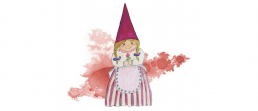
L’avventura Comincia – the Adventure Begins
As an old Italian proverb says, “la fortuna aiuta gli audaci”, yes, fortune favours the brave which is exactly how the Saffirio family has shown through the generations in their love of the land and desire to create extraordinary wines. Although they have farmed here since 1890, perhaps it’s the most recent 3 generations who have demonstrated unwavering courage to do things quite a bit differently. Starting with Ernesto…
L’eroe – the Hero – In 1910 Ernesto Saffirio was born in the village of Castelletto, in the commune of Monforte D’Alba in Piemonte, Italy. As the eldest child, he worked hard to support his family, as his father was away fighting in the First World War. Ernesto was in turn called up during the Second World War. Despite the enormous difficulties that life dished out to Ernesto, he was a strong and determined man who studied diligently and was rewarded with the top job of the Social Security Institute in Cuneo, where he lived after the war. However, his heart remained deeply attached to Castelletto, to the point of acquiring from his brothers’ their plots of inherited land to unite the family property as a whole to resuscitate life into his dearly loved old vineyards.
Una Curiosita’ – the curiously unique label – Despite his hard life, Ernesto Saffirio maintained a childlike soul – every night he recounted to his young daughter Josetta that when he was small, he saw a gnome enter the courtyard of their house in a cart drawn by mice. The fable surrounding these curious creatures was that they helped the farmers in the fields, looked after the animals and the cellar in exchange for a little wine. Young Josetta was captivated. As she went on to have her own children, Josetta recreated the fable on the wine labels to keep these stories alive for her children, Sara and Alessio. Eventually the beauty, symbolism, and originality of these drawings have made Josetta Saffirio’s illustrations famous throughout the world.
“The gnome designs now embody the social responsibility and sustainability at the heart of their business in the 21st century.”
– JS website
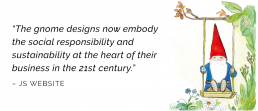
La Leggenda – the Legend – Ernesto’s daughter Josetta was born in 1952 and at only 23 (in 1975) she decided to work in her father’s vineyards. With a degree in agriculture and the help of her oenologist husband Roberto Vezza, she began to cultivate and reinvigorate the vines planted by her grandparents at the end of WWII. Her vision was to transform the family business from merely grape growers into a proud Barolo winery.
She started making wine under her own name, Josetta Saffirio, and describing it with the poetry and her naïve drawings of the colourful gnomes as Ernesto had recounted to her as a child. Several years later, Josetta and Roberto finally reaped the fruit of their labour, producing a Nebbiolo of excellent quality and to wide acclaim. In 1985, they presented their first Barolo with the current gnome label. Finally, Josetta’s extraordinary ‘vin de garage’ Barolo amazes the Italian wine scene achieving the acclaimed Tre Bicchieri in Italy’s prestigious wine guide Gambero Rosso in consecutive years – 1988 and 1989. Josetta Saffirio Barolo had arrived! By her strength and spirit, Josetta had rekindled the previous generations’ love of the land and vinous dreams. So, onto the next generation to continue the “craft-womanship” and dedication.
Even after Josetta’s initial success, by the mid 90’s it had become too much for her and Roberto to manage the vineyards and winery in addition to their other responsibilities. Sadly, for a short time, the winery was closed, and the vineyards were rented.
“We are pieces of a mosaic. We are wine writers, actors of nature, we help plants to grow, as children and we are in contact with the vitality of the earth. The soil, the vine and everything that surrounds us. Wine is a life force, rich in micro-organisms that allow it to evolve. For this reason, it is necessary to work the land with great responsibility towards future generations.”
– JS website
‘La Brava’ – a woman in a man’s world – Enter Sara, Josetta’s daughter, who represents the fifth generation of Saffirio farmers in Monforte d’Alba. An important heritage in terms of responsibility towards past and also to future generations. Sara always loved the vineyards and working with nature. In 1999, at age 19, she started helping her father to make wine, and when she completed her university studies, returned to the family estate full-time. She has devoted herself to using sustainable methods and organics in the vineyards. Thanks to Sara’s uncompromising philosophy and her quality wines, she has forged a respected space within the conservative and very masculine world of winemaking in Italy.
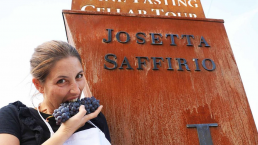
La Filosofia – The Josetta Saffirio Philosophy
The Saffirios seem to be one of the most committed and connected families to the land in the UNESCO World Heritage Barolo area. Their current reputation for terroir-expressive wines, social responsibility and future vision is backed by a familial history of over two centuries within the same commune in Monforte d’Alba.
Despite their rich history, the family also looks to future generations as well. The vineyards are all certified organic (as of 2017), planted ‘giropoggio’ fashion, with rows following the natural contours of the land. Only light machinery is used to avoid soil compaction, and extensive flora between rows also reduces erosion. The farm is part of the consortium ‘Cascina Pulita’, which manages farm waste as sustainably as possible. Not only is the winery 100% carbon neutral, their photovoltaic system produces twice the energy they need. Efforts to reduce their carbon footprint have also involved the use of packaging reduction (lighter glass, shorter corks, and smaller cartons), and the creation of an eco-park with native flora and fauna.
In 2006, the family built an impressive sustainable cellar, integrated with the surroundings, and insulated with natural cork; Sara now uses the facility for vinifying all Josetta Saffirio wines. Her focus on sustainable solutions and technologies resulted in the winery’s receiving a Sustainable Certification in 2015. She, her father, and four employees manage the several colonies of bees kept on the property as well.
From vineyard to bottle, the Saffirio team is fastidious in approach and dedicated to transferring the character of the terroir into exceptional, personality-driven wines. This brings us environmentally harmonious Barolo, Langhe Nebbiolo and Barbera, and with each vintage they share a story of the land, its people, their trials, and successes.
The joy of “terroir” is knowing that when you open a bottle, there is a “story” inside, a story of place and people. Indeed, the wines of Josetta Saffirio all have an immense story and big personalities. We cannot fully explain exactly how the natural aspects of terroir and the choices the vignaiolo (winemaker) made create the multitude of aromas and nuanced tastes in the wines… but they do, and we keep exploring, tasting, enjoying, and learning to understand the Josetta Saffirio terroir through their wines.
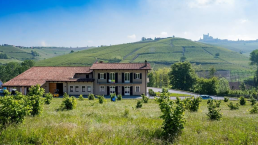
Il Terroir, I Vigneti e La Cantina - The Land, The Vineyards, and The Winery
Only ten minutes away from the village of Barolo, on the top of a hill sits Saffirio’s five hectares of vineyards facing southeast, which are all within the Castelletto subzone of Monforte D’Alba. The looming hill of Castelletto ensures a cooler micro-climate and the wines have a reputation for elegance. At the heart of the vineyard is the Nebbiolo planted by Sara’s grandfather in 1948, the Michet clone has perfectly adapted to the terroir, and it is the stock that has parented subsequent plantings. (Michet is highly valued for the quality and concentration of the wine produced).
The oldest vineyard was planted by Ernesto on Rupestris rootstock which is highly resistant to downy mildew. Many of their new plantings also utilise clones from this vineyard to continue the storyline of the past through their DNA. Their vineyards are polyclonal, thanks to plants selected from thirty years of university research and massal selection – the practice of replanting their new vineyards with cuttings from exceptional old vines from the same property.
The Saffirio soil type is Helvetian-stage, which is exposed seabed formed during the late Miocene, about 10-12 million years ago. It is medium-textured (silt, clay, and sand in equal parts), rich in mineral salts and active lime on a very steep slope (40-50%).
By law, the Barolo DOCG denotes specific production methods and a quality guarantee – they must be 100% Nebbiolo and aged at least 38 months, 18 of those in wood barrels. The term “Riserva” can be used on the label when the wine has been cellared for at least five years. Both with a minimum 13 percent alcohol content.
Vinificazione per il Barolo DOCG: Soft pressing of handpicked grapes followed by destemming. Fermentation in thermostatic tanks at controlled temperature (30-32°C). Maceration lasts 7-9 days followed by racking when fermentation is complete. Immediately following malolactic fermentation, the wine is transferred into barrels, some of them new and some used previously. The wine, decanted each year, is assembled after 24 months in cement vats where it stabilises naturally for another six. Bottling follows in the summer. The wine is bottle-aged for another six months prior to release.
Vinificazione per il Nebbiolo Langhe DOC – 100% Nebbiolo from Monforte d’Alba – Castelletto subzone. Mixed soils composed of silt, clay, and sand, rich in mineral salts and active lime. Langhe Nebbiolos are generally made from declassified fruit from the regions of Barolo, Barbaresco and Nebbiolo d’Alba. At Josetta Saffirio the grapes are handpicked, pressed, and then destemmed; the must is then cold-macerated for about 24 hours. Temperature-controlled fermentation follows in thermostatic vats. After 8-10 days of maceration the wine is racked when fermentation is complete. Following malolactic fermentation in December, Langhe DOC Nebbiolo ages in 30 hl oak barrels for about 12 months. Bottling takes place in the second winter after the harvest.
“For two centuries we grow the vines and tell the area through our wines. Harvest after harvest, we are rooted in the great land of the Langhe.”
– JS website
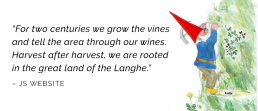
Geek Talk - The Barolo Wars
We all know, Italians are very passionate people. And Italian wine folks are extremely passionate about all things vinous – in this case, barrels! The controversy over the use of French oak barriques versus traditional botti* began in the mid-1980s and took on the dimensions of a holy war – defiantly named the Barolo Wars. The new approach was being promoted by a group of avid winemakers who came to be known as the Barolo Boys, something of a misnomer because winemaker Chiara Boschis is one of the five members of the group.
Anyway, Barolo vintners who are traditionalists use the huge (1,000 – 10,0000 litres) Slavonian oak botti* that may be used over and over for decades. The botti (plural) are used as inert containers; they allow the wine to mature as the pores in the staves are slightly air-permeable, but they don’t impart any oak flavour or aroma into the wine.
Barolo modernists, on the other hand, inspired by the practices of Burgundian winemakers, forego the botti in favour of the much smaller French oak barriques (225litres). By using the barriques, the resulting wines were smoother and way faster-maturing, but the traditionalists believe they become ‘less distinctive’ – less a reflection of true Barolo terroir.
In any case, using barriques was considered revolutionary at the time. Whether the traditionalist or modernist approach results in better wines remains a subject of disagreement among Piemonte’s winemakers even today. Yet many producers nowadays will use a mixture of these two sorts of containers for ageing, depending on the particular vintage and individual vineyard sites.
“I would like to describe to you the feeling I have in April watching the new sprouts, and everything coming back to life after winter. I would like to tell you about the intense and delicate bouquet of Nebbiolo flowers in May. I would like to be able to express the joy in bringing the grapes in the cellar during the harvest in September—the work of a whole year. But it is impossible to do it with words. I hope to tell you about it through my wine.”
– Sara Vezza Saffirio
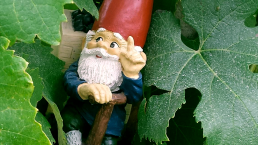
I Vini – The Wines of Josetta Saffirio
It takes great skill to tame the notoriously temperamental Nebbiolo grape. In Sara’s wines you sense the passion and an individuality that are not trapped by someone else’s idea of what Nebbiolo should taste like. And where ‘modern’ wine making has attempted to embellish, stylise, and slather on flavour, Sara is subtly enhancing our taste perceptions. Her goal is to rid the wine of illusions and still taste all the vividness of fruit, liberated from conformity, fashion and worst of all, flavour for flavours sake.
With Barolo fast becoming an expensive collectors’ wine, particularly in highly touted vintages, you’d think that there’s no longer high value treasures to be found. Which is why Josetta Saffirio’s entry level Barolo demands your attention. Energetic and expressive, winemaker Sara Vezza has captured this vintage beautifully. This wine is spot-on in every way and will linger in your palate memory indefinitely. Pounce now!
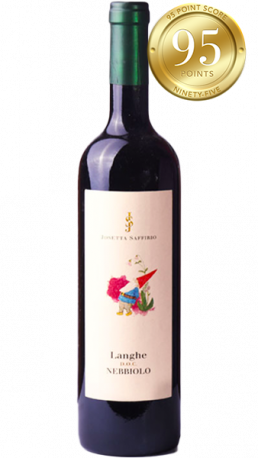
2019 Josetta Saffirio Langhe Nebbiolo
“Bright, ruby-red with a garnet hue, lighter on the rim. The nose is soft and vibrant, sweet fruit of strawberries, cherries aromas interweave floral, spice and subtle note of earth. Full-bodied, aromas of strawberries and cherries accompanied by savoury mealy nuance, unfolding floral and spice details. The palate is salivating, brilliant acidity balanced by the ripeness of fruit and a fine, silky tannin grip; earthy and savoury notes linger to a lasting finish with a hint of spice and floral lifting. This is an approachable Nebbiolo with attractive ripe fruit, acid balance and a silky, smooth tannin grip. Match with truffle shaved pasta pork stew over the next 5+ years. Handpicked, destemmed, pressed to ferment in stainless steel tanks, 10 days post-ferment maceration, after MLF, aged in oak barrels for about 12 months.” 95/100 pts 18.5/20 pts
Candice Chow, Raymond Chan Wine Reviews
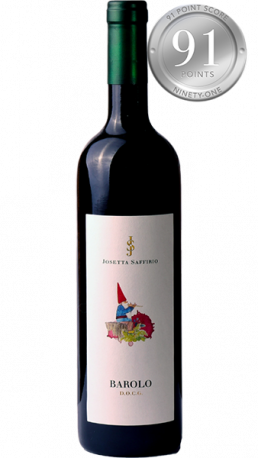
2017 Josetta Saffirio, Barolo
“Rose petals, cherry blossom, and then a flood of intensely sweet, intensely pure cherry fruit. The palate is even more perfumed than the nose, soaring ethereal beauty and intrinsically get earth-connected. If ever a wine reminded me of a giant old tree, its roots deep and wide into the earth, its branches etching the sky, it is this one. I can almost taste (and feel) earth-clad roots, cold wind, rough bark, the vibration of bird wings, sunshine on leaves, the thrum of insects. The fruit has the purity, lift, song, alto timbre of a cello. The finish is poised, purposed, persistent, wrapped in goassamer.” 17.5/20 pts – Jancis Robinson.com
“This opens with alluring aromas of black-skinned berry, cedar, and spice. The polished palate offers ripe black cherry, liquorice, and clove alongside firm tannins.” 91/100pts – Wine Enthusiast Kerin O’Keefe
